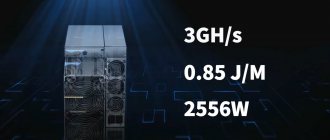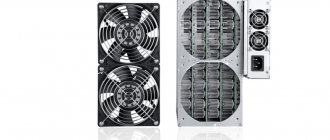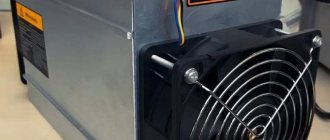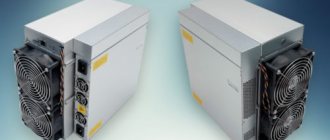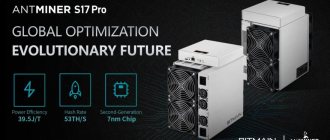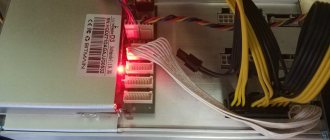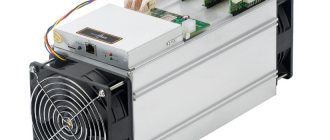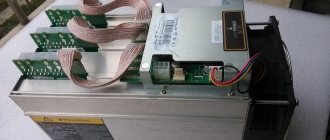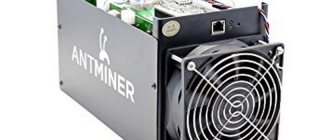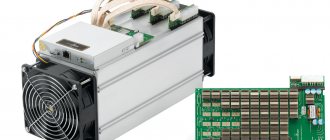Antminer A3 is another device from Bitmain that opens up new mining opportunities, this time using the Blake(2b) algorithm, on which the Siacoin cryptocurrency (SIA) is based.
The cryptocurrency itself appeared back in 2015, but ASIC entered the market quite recently and at first showed simply amazing profitability, and even after a significant decline it continues to remain very profitable.
But how long will this last, or will it happen like with the previous high-profile release from Bitmain – Antminer D3, and after a while mass sales will begin (by the way, we examined this device and the inappropriateness of its sale in a separate article “Review of ASIC miner Antminer D3”)? Buyers' concerns are understandable, especially given the fall in cryptocurrency prices in recent months, which has also affected SIA. Let's look at the characteristics, capabilities and prospects of the new Bitmain product.
Technical characteristics of Antminer A3
The device has the following parameters:
- Algorithm – Blake(2b);
- hashrate – 815 GH per second, normal deviation 5%;
- energy consumption – 1,275 W per hour;
- voltage – 11.6-13 V;
- energy efficiency – 1.56 mJ/Mh;
- working boards – 3, each with 60 BM1720 chips;
- operating temperature – 0-40 °C, optimal window – 10-25 °C;
- dimensions – 321 x 125 x 208 mm;
- weight – 6.5 kg in total, 4.2 kg unpacked;
- noise level – 76 dB at a distance of one meter;
- power supply – APW3++, purchased separately;
- price – $980 on the manufacturer’s website.
Miner capabilities
How much is 815 gigahashes per second? Depends mainly on the power of the network. In the early days after the release of A3, when the entire SIA network had a capacity of hundreds of terahashes, this was an excellent indicator. Now it no longer blows your mind, but you can’t directly compare it with ASICs for mining using the SHA-256 algorithm, which have a power of tens of gigashes – after all, they are much less useful there.
To understand how serious the A3 device is, let's try to compare it with the GeForce GTX 1080Ti video card with a price of about $1,500. When mining on the Blake(2b) protocol, such a video card is capable of delivering a performance of 3 Gh per second, and will spend about 200-250 W per hour. Antminer A3 is capable of delivering 815 Gh per second, that is, 270 times more, spending 6 times more electricity! Therefore, in order to mine as quickly as one ASIC, you will have to buy $400,000 worth of video cards - it’s clear why immediately after its release, when it was necessary to fight specifically with the GPU, the A3 made such a fuss.
Now, when thousands of such ASICs are already working simultaneously, its capabilities look much weaker, but still not bad. Overclocking can help you squeeze more out of the device - however, like all miners from Bitmain, the A3 already works almost to the limit, and therefore you shouldn’t expect much. But overclocking is very simple - the manufacturer carefully included the ability to adjust the frequency directly from the interface, so you don’t have to come up with anything.
Thus, you can get about 900-910 Gh from the A3, but keep in mind that the board temperature should not be higher than 66 °C, and the chips themselves cannot be heated to more than 88 °C. With additional cooling, it is realistic to not go beyond these limits and squeeze out even more performance, but you will have to do this at your own peril and risk.
The 6 month manufacturer's warranty will not apply in case of overclocking.
Why all the fuss?
To understand where such a stir came from around Antminer A3, just look at its parameters. As mentioned above, the ASIC runs on the Blake2b protocol and consumes about 1200 watts. All this allows it to accelerate to 800 GH/s. Manufacturer price: $2,375. Adding up these parameters, you can see that at the start of sales, the miner was generating absolutely fantastic profits - more than $500 daily. The device paid for itself in literally 5 days.
Naturally, such profitability is temporary. Today, the standard hashrate of the Siacoin platform does not exceed 600 Th/s. The power of the A3 reaches 800 GH/s. In order to double the network hashrate, you only need to launch 740 ASICs. Accordingly, the reward for the mined block will also be halved.
It’s unlikely that Bitmain will make do with such a modest batch of machines. Surely, the number of miners will exceed many thousands. However, even if 10 thousand devices are sold, the mining profitability will drop to $30. And this does not take into account price fluctuations. Of course, such earnings are also not bad, but they cannot be compared with five hundred a day.
Of course, this is nothing more than a guess. However, using the example of a similar device from Bitmain, Antminer D3, based on the X11 protocol and originally developed for mining the Dash coin, one can see that immediately after the next batch of machines enters the market, mining profitability can drop several times. The token itself now costs approximately $0.0223. The market capitalization exceeds $700 billion. The currency has been added to all major trading platforms.
Appearance and interfaces of Antminer A3
Externally, the A3 is practically indistinguishable from previous models - such as the D3, or, and, to tell the truth, their filling is approximately the same. The elongated aluminum case, two fans at both ends provide a semblance of a blown pipe - from the design side, there can be no complaints about the Bitmain engineers, it is really effective.
But the problem with noisy and at the same time not particularly efficient fans remains, therefore, when overclocking or installing the device in a living room, it is advisable to replace them with quieter and more efficient ones - fortunately, the cost of such fans is low. At the top of the case there is a control board with status indicators, and there are also connectors for connecting the ASIC to power and Ethernet.
Connecting and setting up Antminer A3
In addition to the ASIC itself, you will need a power supply, which can be purchased either from the manufacturer itself or separately. If you already have a high-quality power supply of the required power, then it is acceptable to use it, otherwise we recommend purchasing it from the manufacturer, since there are no complaints about the power supply from Bitmain: its power is sufficient, and energy efficiency is at a high level (93%). Note that you can use several power supplies, but you should not use two to connect to one board.
Next you need:
- Connect the miner to the power supply, plugging the connectors into the connector until they click, one after the other.
- Connect the power supply to the network.
- Connect the ASIC to the router via an Ethernet cable.
- Determine device IP.
- Select a pool and create an account and a worker on it, enter the pool settings in the ASIC settings.
- You can start mining SIA! If mining does not start, try restarting the device.
For 6 months starting from shipment, the guarantee from Bitmain will be valid and if problems arise with the device, they can be resolved. However, the warranty does not cover all cases: in addition to overclocking, it will not cover breakdowns due to problems with the power supply, power surges, or liquid getting into the device. You should not count on help from the manufacturer even after you have replaced at least one of the components.
ASIC at a discount
Less than a month ago, Bitmain announced big discounts on Antminer A3. If previously the price of the device was $2,375, today the miner is sold for a very affordable $980. Delivery period is standard for such devices 2 months. Such generosity will undoubtedly affect the number of users, and, accordingly, the amount of earnings.
However, one should not take this too seriously. There are no miracles, and an income of $500 daily is rather a privilege for ASIC manufacturers. The Antminer A3 itself will certainly take a leading position in the market, not least because of the promising concept of Siacoin. Everyone involved in mining should pay attention to this device.
Advantages and disadvantages
Summarizing what was written earlier, let’s highlight the pros and cons of the A3, starting with the first:
- The ratio of low price and good performance will allow you to receive a confident income without risking a lot of money.
- Mining using the unique Blake(2b) algorithm, for which there are no other ASICs on the market.
- Reliable operation of the device and warranty from the manufacturer.
- Easy to set up and mine.
Well, the disadvantages:
- Possibility to mine only one cryptocurrency.
- High noise level and low overclocking capabilities.
- The peak efficiency of ASICs has already passed, and in order to get really big profits you should aim for one of the new products.
Start of sales
The Chinese holding Bitmain has launched a new ASIC device based on the Blake2b protocol for mining the digital currency SiaCoin, which can be purchased using the official web portal.
The goods will be sent to you 10 days after payment, which indicates a serious approach and a high level of service. In August 2022, the opportunity was opened to pre-order ASIC Obelisk SC1 from SiaTech, which will hit the shelves only in the spring of this year. This means that those who pre-ordered the first ASIC device for the Siacoin electronic coin will no longer receive that colossal income. However, they will be able to expand the collection of miners supporting the newly minted currency based on Blake2b.
SIA and its mining
Since Siacoin is the only cryptocurrency that can be mined using A3, it is extremely important to evaluate the cryptocurrency's prospects when deciding to purchase this ASIC. After all, it’s one thing if you can’t sell it at a price higher than the current one, and quite another thing if you have the opportunity to accumulate a supply of coins and then sell it many times more expensive.
With Siacoin, it is impossible to clearly say that this will be possible, but the coin has prospects.
SIA itself serves as the internal currency of a distributed storage service that competes with cloud storage giants. Of course, companies such as Amazon and Google have much greater resources, but SIA has a fresh idea on its side: using the hard drives of the users themselves to store information - they are the ones who save the data of other users for a fee in siacoins.
This is much more financially profitable than turning to cloud storage services, and the main issue is ensuring privacy. The system does this using encryption algorithms, as well as distributed storage, thanks to which files are stored on dozens of hard drives in parts at once, making them impossible to read. Whether SIA will become the hegemon of the market or whether it will be able to capture at least a significant part of it - only time will tell, but this is quite possible.
Siacoin - what is it?
Like all other Bitmain devices, Antminer A3 is designed for token mining based on only one algorithm. In this case, it was the Blake2b protocol used by the SiaCoin platform.
The electronic currency itself was born back in 2015 and has already gained considerable popularity among ordinary users. The key difference between SIA and similar projects is the ability to purchase offline file storage for resource coins. In other words, in addition to mining, platform tokens can be earned by renting space on your hard drive.
Issuing coins is by no means the main task of the project developers. First of all, they are aimed at creating a completely independent and autonomous platform for storing information. It was she who was named Sia.
The concept is that anyone, regardless of where they live, can make free space on their hard drive available for use by other users. Such nodes are connected into a global peer-to-peer system, and each, if necessary, is able to rent a section of this space. Stations that offer this service are rewarded in some way. Security, privacy and security of storing various information is guaranteed by the decentralized architecture of the site and advanced encryption algorithms.
The reward mentioned above is the Siacoin cryptocurrency. One token contains 1024 non-dividable units. The stock marker attached to the coin is SC. The platform is based on the Proof-of-Work consensus method. Taking into account the peculiarities of the concept, a completely different type of payment has been introduced in the block chain - “smart contracts” for storing information. The service supports p2pool and is compatible with the multisig electronic wallet.
